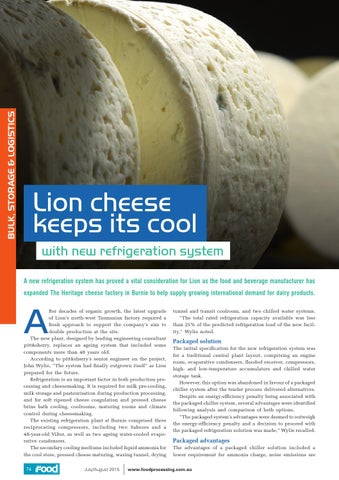BULK, STORAGE & LOGISTICS
Lion cheese keeps its cool with new refrigeration system A new refrigeration system has proved a vital consideration for Lion as the food and beverage manufacturer has expanded The Heritage cheese factory in Burnie to help supply growing international demand for dairy products.
A
fter decades of organic growth, the latest upgrade of Lion’s north-west Tasmanian factory required a fresh approach to support the company’s aim to double production at the site. The new plant, designed by leading engineering consultant pitt&sherry, replaces an ageing system that included some components more than 40 years old. According to pitt&sherry’s senior engineer on the project, John Wylie, “The system had finally outgrown itself” as Lion prepared for the future. Refrigeration is an important factor in both production processing and cheesemaking. It is required for milk pre-cooling, milk storage and pasteurisation during production processing, and for soft ripened cheese coagulation and pressed cheese brine bath cooling, coolrooms, maturing rooms and climate control during cheesemaking. The existing refrigeration plant at Burnie comprised three reciprocating compressors, including two Sabroes and a 40-year-old Vilter, as well as two ageing water-cooled evaporative condensers. The secondary cooling mediums included liquid ammonia for the cool store, pressed cheese maturing, waxing tunnel, drying 74
July/August 2015
tunnel and transit coolroom, and two chilled water systems. “The total rated refrigeration capacity available was less than 25% of the predicted refrigeration load of the new facility,” Wylie noted.
Packaged solution The initial specification for the new refrigeration system was for a traditional central plant layout, comprising an engine room, evaporative condensers, flooded receiver, compressors, high- and low-temperature accumulators and chilled water storage tank. However, this option was abandoned in favour of a packaged chiller system after the tender process delivered alternatives. Despite an energy-efficiency penalty being associated with the packaged chiller system, several advantages were identified following analysis and comparison of both options. “The packaged system’s advantages were deemed to outweigh the energy-efficiency penalty and a decision to proceed with the packaged refrigeration solution was made,” Wylie recalled.
Packaged advantages The advantages of a packaged chiller solution included a lower requirement for ammonia charge, noise emissions are
www.foodprocessing.com.au
